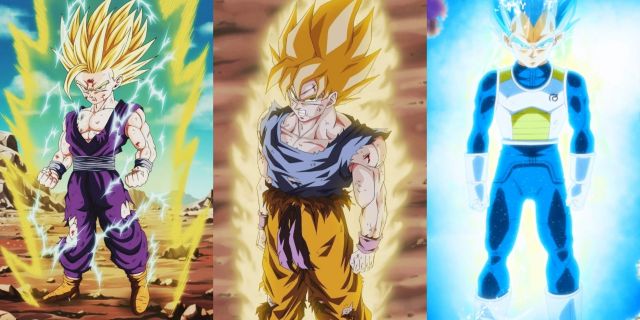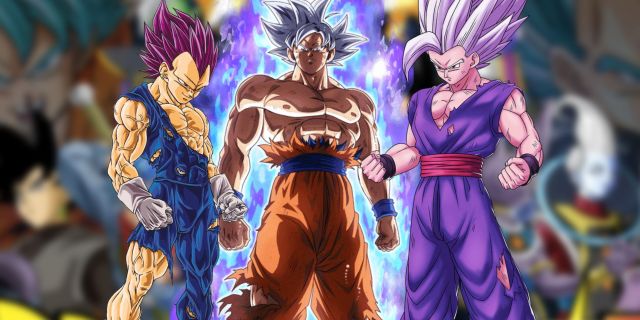Highlights
- Transformations in Dragon Ball serve as a measure of character growth and development for the main cast, pushing them to new limits.
- While transformations have become a staple in the series, the formula may be reaching a saturation point, leading to questions about reliance.
- The narrative and thematic significance of transformations has evolved over time, with more recent forms being achieved through training rather than awakenings in battle.
Ever since the debut of the Super Saiyan form during the Frieza Saga of Dragon Ball Z, Akira Toriyama has made clever use of transformations in every successive arc within the Dragon Ball franchise. While their narrative significance may not have been on par with Goku’s first transformation on the planet Namek, new Super Saiyan forms played a crucial role in solving Dragon Ball Z’s subsequent major battles.
Such a trend can also be seen in more recent entries, like Dragon Ball Super, where transformations have served as a method to measure the development of the main cast. As Goku, Vegeta, Gohan, and Piccolo keep pushing each other’s limits as well as their own in search of greater power, the battle shonen trope of introducing new forms to embody their growth has now begun to reach a saturation point. In this regard, has Dragon Ball become too reliant on transformations to keep its story moving?
The Role Of Transformations In Dragon Ball
In Dragon Ball Z, transformations were more than simple power ups or updated character designs. New forms came to embody the culmination of important character arcs, signifying personal growth or coming-of-age moments, and the first two Super Saiyan forms stand testament to this perspective.
For instance, Gohan’s Super Saiyan 2 transformation in the Cell Games Saga is perhaps the best example of how such an approach to anime power ups can bring a character’s journey full circle. Having been slowly built up over several arcs, this transformation also indicated the passing of the torch from father to son, where Gohan was now ready to take on Goku’s responsibility of protecting Earth.
Beyond this, transformations also played a role in the series’ gradual power creep, which raised the stakes with each successive story arc. Antagonists that were once insurmountable threats, turned into trifling opponents when a new Super Saiyan form was introduced. While this formula held good up until the Cell Saga, Toriyama chose to redefine the role of his transformations in the subsequent Majin Buu Saga, where they were no longer an indication of assured victory and only gave the main cast a fighting chance where there was previously no hope.
How Were Battles Resolved Before Super Saiyan?

Prior to Super Saiyan’s genre-defining introduction, fights in Dragon Ball Z were often decided by a combination of ingenuity, teamwork, and endurance. Battles of attrition were the norm, and it was not uncommon for characters to simply gain power through resolve or heightened emotions, only to falter as their opponent, in turn, attained a boost in strength of their own.
Viewing battles like these always had users on the edges of their seats, since there was no telling who would come out on top when both sides were constantly one-upping each other. Even the Kaio-ken, a predecessor to Super Saiyan, held huge dangers if overused, which heightened the tension each time Goku harnessed it to push his body beyond its limits.
Conversely, after transformations became the norm, viewers could clearly see that a battle was approaching its endgame when a new form appeared. Even in tense situations where the Dragon Team were at a disadvantage, there would always be a solution that arose as a consequence of a transformation, which forced Toriyama to get even more innovative in writing his fights towards the end of Dragon Ball Z, to prevent the formula from becoming stale.
New Power Systems, Same Old Answers
When the seeds of Dragon Ball Super were sown in Dragon Ball Z: Battle of Gods, there was a considerable shift in the series’ direction, where conflicts were no longer desperate struggles for survival, and there was greater focus on tournament arcs. This is not to say that all sense of danger in the series completely evaporated, as arcs such as the Golden Frieza Saga, the Future Trunks Saga, and the Universe Survival Saga featuring the Tournament of Power, had massive stakes.
With this, came the introduction of a new power system based on godly ki, through the debut of the Super Saiyan God form. Although certain aspects of this form are intriguing, the subsequent evolution of this form to Super Saiyan Blue hinted that not a lot had changed in how transformations were portrayed. Quite a few fights at this point consisted of characters upping the ante by switching from one transformation to the next, which was bound to grow tiring after a certain point.
Moreover, one crucial aspect of transformations in Dragon Ball Z — their narrative and thematic significance for a character — had all but disappeared, since these two new forms were achieved through training rather than awakenings in the heat of battle. Fortunately, this was soon rectified through character-specific forms, which brought this important facet of transformations back into the fold.
Goku’s awakening of Ultra Instinct stands testament to this, and it is now one of his most iconic forms. Similarly, Vegeta, Gohan, Piccolo, and Frieza all followed suit, with Ultra Ego, Beast, Orange Piccolo, and Black Frieza, which each signified a turning point in their respective character arcs. Simultaneously, in the Dragon Ball Super manga, Goku also displayed variants of Ultra Instinct, which posits an innovative new take on how a transformation can be given a longer shelf life, before a newer, more powerful form takes its place.
What Can Be Done To Rectify This?
It goes without saying that transformations are innately bound to the identity of the Dragon Ball franchise in every respect, and in the past, they were one of its greatest triumphs. Nearly every battle shonen anime and manga transformation since owes some debt to Akira Toriyama’s work, and his influence on these mediums cannot be understated by any means.
The franchise’s commercial success also has a lot riding on the unveiling of new transformations, due to the revenue brought in by collectible figurines, action figures, and other merchandise. Hence, it is not likely that the series will abandon this approach anytime soon. Looking at power ups in Dragon Ball and Dragon Ball Zprior to Super Saiyan, it is not too hard to see that they were mainly limited techniques or new fighting styles.
Revisiting this approach to character progression, or introducing new ideas into the prevailing power system, might provide some respite from the endless stream of new forms that has come to define the series. However, whether these strategies will prove to be successful really hinges on the quality of the design and the narrative arc leading into the power up’s reveal. For now, it seems like transformations are not going anywhere for a while, but there is a clear need for the franchise to explore new territory, before its fan base grows weary of the age-old formula it has been following for decades.
Dragon Ball Z is available to stream on Crunchyroll.
